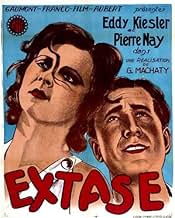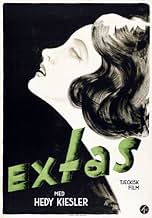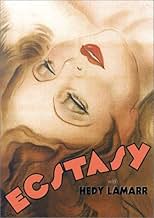IMDb-BEWERTUNG
6,6/10
2975
IHRE BEWERTUNG
Eva hat gerade einen älteren Herrn geheiratet. Sie verlässt ihn, und eines Tages lernt sie einen jungen Mann kennen und sie verlieben sich. Das Schicksal bringt den Ehemann mit dem jungen Li... Alles lesenEva hat gerade einen älteren Herrn geheiratet. Sie verlässt ihn, und eines Tages lernt sie einen jungen Mann kennen und sie verlieben sich. Das Schicksal bringt den Ehemann mit dem jungen Liebhaber zusammen, der ihm Eva genommen hat.Eva hat gerade einen älteren Herrn geheiratet. Sie verlässt ihn, und eines Tages lernt sie einen jungen Mann kennen und sie verlieben sich. Das Schicksal bringt den Ehemann mit dem jungen Liebhaber zusammen, der ihm Eva genommen hat.
- Auszeichnungen
- 2 Gewinne & 1 Nominierung insgesamt
Hedy Lamarr
- Eva Hermann
- (as Hedy Kiesler)
Emil Jerman
- Eva's husband
- (Synchronisation)
Antonín Kubový
- Landarbeiter
- (as Antonin Kibový)
Bedrich Vrbský
- Eva's father
- (Synchronisation)
Jirina Stepnicková
- Eva
- (Synchronisation)
Ladislav Bohác
- Adam
- (Nicht genannt)
Comedian Harmonists
- Themselves
- (Nicht genannt)
Kani Kipçak
- Dr. Brady
- (Nicht genannt)
Karel Macha-Kuca
- Der Rechtsanwalt
- (Nicht genannt)
Jirina Steimarová
- Typist
- (Nicht genannt)
Empfohlene Bewertungen
This is one that sent church and censors in disarray when it made its way to America, no doubt for the divorced woman who runs fully naked through the woods. The things people would be so uptight about, so tame to us now. But it introduced Lamarr to Hollywood.
A young woman then who yearns to be open to sense things, live life, but she's stifled by thankless marriage. The whole plot is typical, what they were calling kammerspiel in Germany, about the twists and turns of love, until the moral denouement that inevitably parts lovers.
But instead of narrowing down to a room and stage, it opens up sense to things, we have a poetry of evocative skies, nature, reflections, glances of the eye that conjoin a wider world. In many respects it might as well have been a silent, dialogue is scant.
And it does more than paint in fact, it paints the state of mind that gives rise to the pulls that create narrative. You'll see this in the famous scene mentioned above, where capricious horse nature sends her out to meet her mate. Or the marvelous scene later that night of anxiously being unsure if she wants to go to his house, rendered with wind through an empty house and dark rolling skies above.
It's simple in contrasts and goes down rather easy but dressed and timed to resonate. The ex husband languishing in an empty room while the lovers are greeted with music in the tavern next door. Love isn't allowed last say however as if that would be too upsetting for the social norm.
But something else is, more poignant eventually.
The ending shows a working site with tools strewn about, deserted at morning. But does life stop in its tracks because a woman left? We now see workers file in and joyously go to work, the work of doing is resumed with song, the ground transformed, a faucet turned on and waters of life pour freely. It's the most vital scene in the film, emulating the Soviet filmmakers but so good it's worthy of being in Zemlya.
A young woman then who yearns to be open to sense things, live life, but she's stifled by thankless marriage. The whole plot is typical, what they were calling kammerspiel in Germany, about the twists and turns of love, until the moral denouement that inevitably parts lovers.
But instead of narrowing down to a room and stage, it opens up sense to things, we have a poetry of evocative skies, nature, reflections, glances of the eye that conjoin a wider world. In many respects it might as well have been a silent, dialogue is scant.
And it does more than paint in fact, it paints the state of mind that gives rise to the pulls that create narrative. You'll see this in the famous scene mentioned above, where capricious horse nature sends her out to meet her mate. Or the marvelous scene later that night of anxiously being unsure if she wants to go to his house, rendered with wind through an empty house and dark rolling skies above.
It's simple in contrasts and goes down rather easy but dressed and timed to resonate. The ex husband languishing in an empty room while the lovers are greeted with music in the tavern next door. Love isn't allowed last say however as if that would be too upsetting for the social norm.
But something else is, more poignant eventually.
The ending shows a working site with tools strewn about, deserted at morning. But does life stop in its tracks because a woman left? We now see workers file in and joyously go to work, the work of doing is resumed with song, the ground transformed, a faucet turned on and waters of life pour freely. It's the most vital scene in the film, emulating the Soviet filmmakers but so good it's worthy of being in Zemlya.
This is romanticism in the original 18th and 19th century sense of exalting human emotion and imagination, depicting the nature of sex and human relations in terms of powerful, elemental forces mirrored and symbolized in nature. It's prototypical also of European art cinema, which I've always had a weakness for. A romance, yes, but not in the sense of some smarmy "relationship" flick. All that aside, it's just strikingly beautiful, and a real treat for people who relish earlier styles of film-making. On reading some brief blurbs about the new DVD edition before getting it, I kind of got the impression that it was some cheap "shocker" in the manner of "Sex Madness" or "Reefer Madness," which couldn't be further from the truth.
As has been remarked, it's practically a silent film with a continuous musical score. Released very early in the 1930s, I have to wonder if it wasn't originally conceived and largely shot as a silent, and retrofitted for sound. Spoken lines are never more than a brief sentence or two, and most often just one or two words. This is at a time when American films were thick with dialog, taking full advantage of the new sound technology. I think much of the communicative power of cinematography was shoved aside or forgotten with the advent of sound. Had this picture been done in the United States at that time, quite apart from the demands of the sensors, a continuous patter of verbal exposition and just plain yammering would have been insisted-on by those financing it. Thankfully, it wasn't, and we still have this almost-forgotten gem to show for it.
The direction and cinematography isn't really revolutionary for its time, as it uses techniques, camera tricks, editing and points-of-view that had already been invented by earlier pioneers of silent film, but their presence still makes it stand strikingly apart from the vast majority of mainstream films of the era. There is visual sexual symbolism obvious enough to raise a giggle or two from some modern viewers (Eva pensively toys with her ring while lying on the bed on her wedding night, one drooping flower drips into another receptively open flower after a violent rainstorm). It's hardly out of place, as sex is at the very center of the film.
The musical score is extremely specific to the action, and is highly lyrical. It may strike some modern viewers as a bit too cloyingly sweet, but I find it appropriate to the style and powerfully effective for getting you into the spirit of the piece. It helps evoke the wide range of mood in the film, which at the very start almost looks like a whimsical romantic comedy. The mood darkens considerably as it moves on.
A story is told powerfully and with great visual artistry, without any superfluous exposition or jabber. For me, it's the essence of cinema. It was a big surprise for me, and I'm grateful for the opportunity to finally see it.
As has been remarked, it's practically a silent film with a continuous musical score. Released very early in the 1930s, I have to wonder if it wasn't originally conceived and largely shot as a silent, and retrofitted for sound. Spoken lines are never more than a brief sentence or two, and most often just one or two words. This is at a time when American films were thick with dialog, taking full advantage of the new sound technology. I think much of the communicative power of cinematography was shoved aside or forgotten with the advent of sound. Had this picture been done in the United States at that time, quite apart from the demands of the sensors, a continuous patter of verbal exposition and just plain yammering would have been insisted-on by those financing it. Thankfully, it wasn't, and we still have this almost-forgotten gem to show for it.
The direction and cinematography isn't really revolutionary for its time, as it uses techniques, camera tricks, editing and points-of-view that had already been invented by earlier pioneers of silent film, but their presence still makes it stand strikingly apart from the vast majority of mainstream films of the era. There is visual sexual symbolism obvious enough to raise a giggle or two from some modern viewers (Eva pensively toys with her ring while lying on the bed on her wedding night, one drooping flower drips into another receptively open flower after a violent rainstorm). It's hardly out of place, as sex is at the very center of the film.
The musical score is extremely specific to the action, and is highly lyrical. It may strike some modern viewers as a bit too cloyingly sweet, but I find it appropriate to the style and powerfully effective for getting you into the spirit of the piece. It helps evoke the wide range of mood in the film, which at the very start almost looks like a whimsical romantic comedy. The mood darkens considerably as it moves on.
A story is told powerfully and with great visual artistry, without any superfluous exposition or jabber. For me, it's the essence of cinema. It was a big surprise for me, and I'm grateful for the opportunity to finally see it.
This early German talkie stars the gorgeous Hedy Lamarr as a bored hausfrau and is notorious for not only showing her in her birthday suit but also in the throes of passion. The film was banned in the US! For that reason alone, one should watch it. Lamarr is truly beautiful and offers a strong performance as the woman who falls for the security of an older man (and marries him) only to become restless and subsequently enthralled with a younger, more exciting lover.
There's no entertainment value in this confusing montage fest. There's a love triangle melodrama wrapped inside, but it's not worth the price of admission. I suspect the film is dripping with all sorts of symbolism, but what it says is never entirely clear. We get shots of flowers, horses, pick axes, and flies, flies, flies. The artsy montages interrupt the story whenever possible and go on and on, overstaying their welcome after delivering their messages.
This practically silent Czech-made movie is notable today for its nude and erotic scenes with Hedy Lamarr, years before she became a star in Hollywood. The scenes, tastefully done, really pushed the envelope back in the early 1930s, giving this film some historical significance.
It boggles my mind to see so many rave reviews for this film. Sure, it has its claims to cinematic history, but this is not a very good film. It is way too drawn out, weighed down by heavy-handed symbolism, and ultimately unsatisfying. A footnote in a textbook, sure, but no masterpiece.
Perhaps one must possess a certain artistic mind to fully appreciate this film's "poetry". If that is the case, I guess I just don't have it.
Not worth your time except as a curiosity for the rabid cinephile.
This practically silent Czech-made movie is notable today for its nude and erotic scenes with Hedy Lamarr, years before she became a star in Hollywood. The scenes, tastefully done, really pushed the envelope back in the early 1930s, giving this film some historical significance.
It boggles my mind to see so many rave reviews for this film. Sure, it has its claims to cinematic history, but this is not a very good film. It is way too drawn out, weighed down by heavy-handed symbolism, and ultimately unsatisfying. A footnote in a textbook, sure, but no masterpiece.
Perhaps one must possess a certain artistic mind to fully appreciate this film's "poetry". If that is the case, I guess I just don't have it.
Not worth your time except as a curiosity for the rabid cinephile.
Eva (Hedy Lamarr) has just got married with an older man and in the honeymoon, she realizes that her husband does not desire her. Her disappointment with the marriage and the privation of love, makes Eva returning to her father's home in a farm, leaving her husband. One afternoon, while bathing in a lake, her horse escapes with her clothes and an young worker retrieves and gives them back to Eva. They fall in love for each other and become lovers. Later, her husband misses her and tries to have Eva back home. Eva refuses, and fortune leads the trio to the same place, ending the affair in a tragic way.
I have just watched "Extase" for the first time, and the first remark I have is relative to the horrible quality of the VHS released in Brazil by the Brazilian distributor Video Network: the movie has only 75 minutes running time, and it seems that it was used different reels of film. There are some parts totally damaged, and other parts very damaged. Therefore, the beauty of the images in not achieved by the Brazilian viewer, if he has a chance to find this rare VHS in a rental or for sale. The film is practically a silent movie, the story is very dated and has only a few lines. Consequently, the characters are badly developed. However, this movie is also very daring, with the exposure of Hedy Lamarr beautiful breasts and naked fat body for the present standards of beauty. Another fantastic point is the poetic and metaphoric used of flowers, symbolizing the intercourse between Eva and her lover. The way the director conducts the scenes to show the needs and privation of Eva is very clear. The non-conclusive end is also very unusual for a 1933 movie. I liked this movie, but I hope one day have a chance to see a 87 minutes restored version. My vote is eight.
Title (Brazil): "Êxtase" ("Ecstasy")
I have just watched "Extase" for the first time, and the first remark I have is relative to the horrible quality of the VHS released in Brazil by the Brazilian distributor Video Network: the movie has only 75 minutes running time, and it seems that it was used different reels of film. There are some parts totally damaged, and other parts very damaged. Therefore, the beauty of the images in not achieved by the Brazilian viewer, if he has a chance to find this rare VHS in a rental or for sale. The film is practically a silent movie, the story is very dated and has only a few lines. Consequently, the characters are badly developed. However, this movie is also very daring, with the exposure of Hedy Lamarr beautiful breasts and naked fat body for the present standards of beauty. Another fantastic point is the poetic and metaphoric used of flowers, symbolizing the intercourse between Eva and her lover. The way the director conducts the scenes to show the needs and privation of Eva is very clear. The non-conclusive end is also very unusual for a 1933 movie. I liked this movie, but I hope one day have a chance to see a 87 minutes restored version. My vote is eight.
Title (Brazil): "Êxtase" ("Ecstasy")
Wusstest du schon
- WissenswertesFirst surviving non-pornographic film to depict a woman having an orgasm.
- PatzerIn the beginning when Emil is in the bedroom, a closeup of the photo on the bedside table is shown to have writing on it. On the second closeup, when Emil is carefully rearranging his keys and other items, there is no writing.
- Zitate
Eva Hermann: Tell him... no. Don't tell him anything.
- Alternative VersionenTo get the film around the more conservative German censors, an alternate version of Hedy Lamarr's nude bathing scenes was shot in which she was partially obscured by strategically-placed bushes.
- VerbindungenEdited into Geschichte(n) des Kinos: Fatale beauté (1994)
Top-Auswahl
Melde dich zum Bewerten an und greife auf die Watchlist für personalisierte Empfehlungen zu.
- How long is Ecstasy?Powered by Alexa
Details
- Laufzeit
- 1 Std. 22 Min.(82 min)
- Farbe
- Sound-Mix
- Seitenverhältnis
- 1.19 : 1
Zu dieser Seite beitragen
Bearbeitung vorschlagen oder fehlenden Inhalt hinzufügen



















